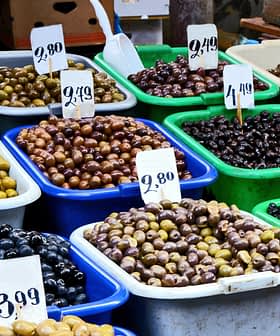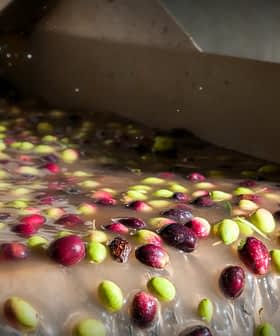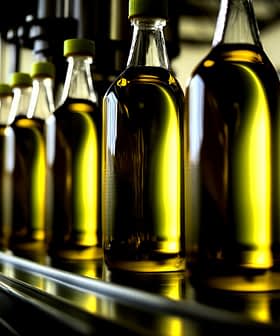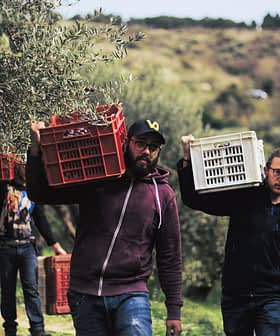California Olive Farmers Turn to Birds for Natural Pest Control
Olive farmers are boosting bird populations and biodiversity by creating and preserving bird-friendly habitats to help control pests.
 Red-tailed hawk (Buteo jamaicensis)
Red-tailed hawk (Buteo jamaicensis)  8.4K reads
8.4K readsCalifornia farmers are working to control pests in olive groves without harmful chemicals by creating diverse habitats to attract beneficial bird species. Encouraging bird-friendly habitats not only helps control pests like olive fruit flies, but also fosters a holistic ecosystem and provides a range of benefits to olive farmers, such as natural pest controllers and mobile fertilizers. The Wild Farm Alliance recommends strategies like adding perches, nest sites, and water sources to support beneficial birds on olive farms as part of a holistic approach to integrated pest management.
Since the launch of California’s sustainable pest management roadmap in January, farmers and officials across the Golden State have been working to control pests without harmful chemical interventions.
Farmers are doing this in the state’s olive groves by creating diverse habits to appeal to beneficial bird species.
Studies show that olive fruit eaten by birds mostly contained larvae, suggesting that birds do not hurt production.
“Studies show birds are foraging on a variety of crops, including olives,” Jo Ann Baumgartner, the executive director of the Wild Farm Alliance, told Olive Oil Times. “The most impactful thing a farmer can do to increase avian pest control is to add diverse habitat to the farm.”
“This can be in the form of native plant species as well as nest boxes to diversify the bird community,” she added. “The more bird species present, the more pest control.”
See Also:Organic Growers Rely on Traditional, Natural Methods to Combat FlyLiz Tagami, the general manager of Lucero Olive Oil, told Olive Oil Times that encouraging bird-friendly habitats helps to foster a holistic ecosystem and provides a range of benefits to olive farmers.
“We gain natural pest controllers with insectivores such as chickadees in the spring or goldfinches and juncos in the fall,” she said. “These little birds act as mobile fertilizers because their droppings contribute nitrogen and phosphorus, enhancing soil health without petrochemical inputs.”
Located in Corning, California, Tagami said native trees, including mature valley oak, divide the main blocks of olive groves and provide habitats for larger birds of prey, which help maintain a balanced ecosystem.
“We routinely see Cooper’s and red-tailed hawks along with kestrels hunting for ground squirrels and other rodents during the day – little pests that can wreak havoc with irrigation systems and tree roots,” Tagami said.

American kestrel
Since 2000, the Wild Farm Alliance has worked with farmers to achieve healthy, viable agriculture that protects and restores wild nature. The alliance recommends various strategies for farmers who want to encourage birds as pest control allies, including adding perches and nest sites.
“Whether artificial poles, snags, perennial trees and shrub or annual tall plants, these can all serve as hunting perches for large raptors and small birds,” Baumgartner said. “Placing nest boxes and nest shelves and allowing birds to nest in barns under eaves or on the ground provide them with the nesting sites they seek for raising their young.”
Birds help reduce olive fruit flies in two stages: larvae in the fruit and pupae on the ground. “Studies show that olive fruit eaten by birds mostly contained larvae, suggesting that birds do not hurt production,” Baumgartner said.
“Birds consumed 65 to 71 percent of the pupae in the soil, and ants attacked most of the rest,” she added. “Further, birds were one of several important predators of olive fruit fly pupae along with ants, beetles and centipedes.”
See Also:Training Young Farmers on Climate-Smart Practices in CaliforniaOlive producers can create bird-friendly habitats as part of a holistic approach to integrated pest management. “Setting aside extra acreage along perimeters for native plants that support birds and insects is a key component in a complete system,” Tagami said.
Native hedgerows are increasingly popular. “This can be accomplished with a ‘pollinator hedgerow’ of densely planted native perennial grasses, shrubs and small trees – not oleander, despite its ubiquity in California,” Tagami said. “Oleander is a non-native and invasive species, which is toxic to birds and animals.”
“In addition to a native pollinator hedgerow, areas without mature trees adjacent to the property are well served to install owl boxes; we’ll be employing both strategies in a smaller orchard being planted next spring,” she added.
Baumgartner underlined four best practices to support beneficial birds on California olive farms: careful pruning and harvesting, adding native habitat, removing invasive species and providing water.
See Also:Intensive Agriculture Blamed for Bird Population Decline in Spain“Native bird species have evolved to utilize native plants. Birds have adapted their migration patterns, breeding seasons, behavior and morphology to suit best the landscape in which they evolved,” Baumgartner said. “A good way to limit invasive species while also helping native bird populations is to monitor for introductions regularly and immediately manage them before they spread.”
In terms of providing water, birds and wildlife need water year-round to survive. Various water sources attract a diversity of birds, giving them somewhere to drink, feed and breed.
“People tend to think of birds as either pests or as beneficial, but oftentimes it’s not so straightforward,” Baumgartner said. “The season, a bird’s life cycle and available food sources will dictate whether a bird will provide pest control services or will damage a crop.”
“Most songbirds are beneficial during the nesting season as they feed pest insects to their ravenous nestlings, and many of these songbirds will continue to eat insects throughout the year,” she added.
“Most omnivores, however, will switch to a plant-based diet in the fall. The omnivores that congregate in large flocks (think blackbirds and starlings) will become a nuisance as they eat fruit or nuts before harvest,” Baumgartner continued.
“If the window for damage can be managed, the overall benefit to the crop can be maintained,” she said. “Another aspect to keep in mind is that birds not only eat insects directly, but they also clean up mummy fruit and nuts that would harbor overwintering pest insects and diseases. This will save farmers on removal of mummified fruits and nuts post-harvest.”
Integrated pest management is part of a larger picture of regenerative and resilient agriculture practices.
“Folks who are not part of daily operations tend to forget that IPM and regenerative practices are dynamic,” Tagami said. “Each property is unique, and strategies must be deployed, monitored and adjusted to ensure goals are met.”
“Biodiversity loss due to habitat loss – whether through commercial development, the spread of non-native plant species or the fast-moving climate crises – presents a complex and interconnected puzzle,” she concluded. “It’s in the farmer’s best interest to build these resilient and sustainable systems, and doing so takes time.”
Share this article









